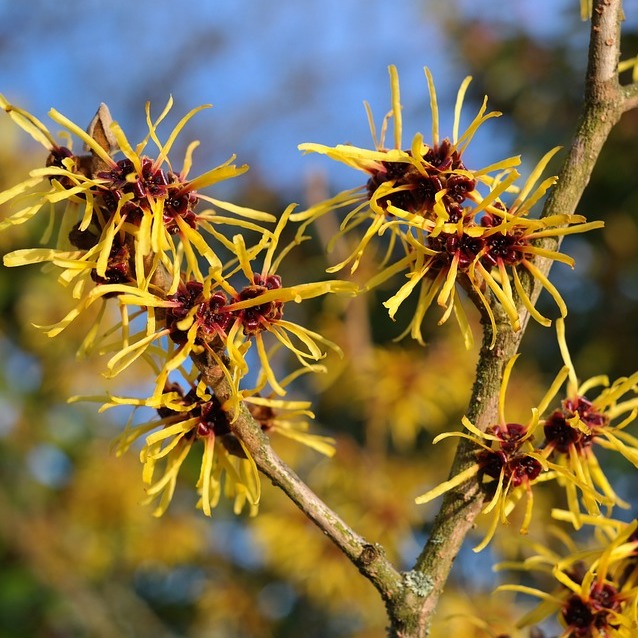Hamamelis virginiana: 'Witch Hazel'
Latin name: Hamamelis virginiana
Common name: Witch Hazel
Flowers: 1 inch yellow strap-like flowers, blooms September-December 10
Fruit or cones: Brown fruit 10
Height & Width: 6-12 ft 10
Type: Deciduous 10
Habit: Upright, tree 10
Wetland indicator category**: FACU 17
Texture: Medium 10
Growth rate: Medium 10
Light: Part-shade, shade 10
Moisture: Dry-moist 10
Soil*: Acidic pH<6.8, rich well-drained soil 10
Zones: 3-8 12
Origin: SE-NE regions 16
Ecosystem benefits: Food or habitat for wildlife, medicinal use 10

Features: Attractive yellow, strap-like flowers in the fall, green foliage in spring-summer. Flowers also fragrant. Fruit from tree feeds birds and deer. Has medicinal uses 10.
Siting: Part-shade, shade with well-drained, rich soil. Acidic soils 10. Can tolerate heavy clay soils 12.
Care: Plant so root flare is visible at soil surface 14. At planting, water the root ball daily with two gallons of water per inch of trunk diameter for two weeks, every other day for two months and then weekly until established. Modify water recommendations to reflect site drainage and rainfall. Apply 3” of mulch over the planted area. Do not allow mulch to touch the trunk 14.
Pests: Plants are relatively pest resistant if cultural preferences are met 10.
This plant does not appear on the following invasive plant lists on (10-19-20):
- USDA SC Invasive Plant Species Web site at http://www.invasivespeciesinfo.gov/plants/main.shtml
- SC Exotic Plant Pest Council Web site at http://www.se-eppc.org/southcarolina/
Author: Reese Bryant
Image source: http://keystonewildflowers.com/plants/shrubs-vines/hamamelis-virginiana-witch-hazel/
Sources:
- Armitage, A. (2001). Armitage’s manual of annuals, biennials, and half-hardy perennials. Portland, OR: Timber Press.
- Armitage, A. (2006). Armitage’s native plants for North American gardens. Portland, Oregon: Timber Press.
- Armitage, A. (2008). Herbaceous perennial plants: A treatise on their identification, culture, and garden attributes. Athens, GA: University of Georgia.
- Clemson Cooperative Extension Home and Garden Information Center.(2011). Flowers fact sheets. Retrieved from https://hgic.clemson.edu/category/flowers/
- Clemson Cooperative Extension Home and Garden Information Center.(2011). Groundcovers & vines fact sheets. Retrieved from https://hgic.clemson.edu/category/groundcovers/
- Clemson Cooperative Extension Home and Garden Information Center.(2011). Trees. Retrieved from https://hgic.clemson.edu/category/trees/
- Clemson Cooperative Extension Home and Garden Information Center.(2011). Shrubs. Retrieved from https://hgic.clemson.edu/category/shrubs/
- Dirr, M. A. (2009). Manual of woody landscape plants. Champaign, IL: Stipes Publishing.
- Gilman, E. F. (1997). Trees for urban and suburban landscapes. Albany, NY: Delmar Publishers.
- Lady Bird Johnson Wildflower Center University of Texas at Austin. (2012). Native plant information network. Retrieved from http://www.wildflower.org/explore/
- McMillan, P., Plant taxonomist Clemson University, personal communication.
- Missouri Botanical Garden Kemper Center for Home Gardening. Plant finder. Retrieved from http://www.mobot.org/gardeninghelp/plantfinder/Alpha.asp
- North Carolina State University (2005). Plant fact sheets. Retrieved from http://www.ces.ncsu.edu/depts/hort/consumer/factsheets/index.html
- Strother, E. V., Ham, D. L., Gilland, L. (2003) Urban tree species guide: Choosing the right tree for the right place. Columbia, SC: South Carolina Forestry Commission.
- University of Florida, IFAS Extension. (2011). Southern trees fact sheet. Retrieved from http://edis.ifas.ufl.edu/department_envhort-trees
- USDA . Plant profile. (n/d).Retrieved from http://plants.usda.gov/java/
- USDA. Plant wetland indicator status. (n/d). Retrieved from http://plants.usda.gov/wetland.html
- Vincent, E., Environmental horticulturist Clemson University, personal communication.
- Clemson Extension. Carolina Yards Plant Database. Retrieved from https://www.clemson.edu/extension/carolinayards/plant-database/index.htm
*Soil pH is determined using a professional soil test. Contact your Clemson University County Extension service for assistance www.clemson.edu/extension/. Click on “local offices”.
**2012 Plant Wetland Indicator categories (quantitative derived) http://plants.usda.gov/wetinfo.html
|
Indicator Code |
Indicator Status |
Comment |
|
OBL |
Obligate Wetland |
Almost always is a hydrophyte, rarely in uplands |
|
FACW |
Facultative Wetland |
Usually is a hydrophyte but occasionally found in uplands |
|
FAC |
Facultative |
Commonly occurs as either a hydrophyte or non-hydrophyte |
|
FACU |
Facultative Upland |
Occasionally is a hydrophyte but usually occurs in uplands |
|
UPL |
Obligate Upland |
Rarely is a hydrophyte, almost always in uplands |
